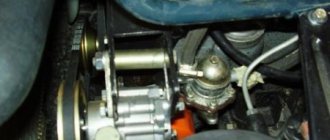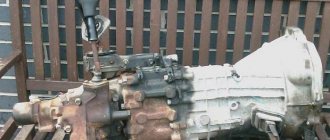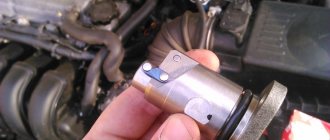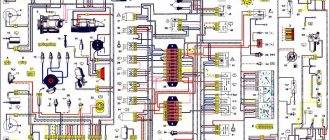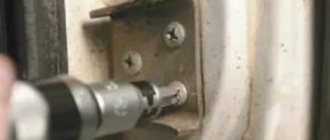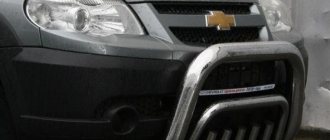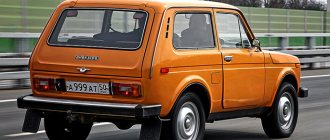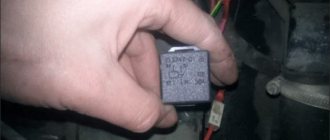Product added to bookmarks!
- Description
- Reviews
Shock absorbers for VAZ 2121, 2131 (NIVA).
SS20 company
offers reinforced rear shock absorbers on
NIVU
, which, unlike the standard shock absorbers
of the VAZ 2121, 2131,
have increased resistance during the rebound stroke, an increased diameter of the body and rod.
APPLICABILITY: VAZ 2121, 2131 (NIVA).
Advantages of using SS20 shock absorbers in NIVA cars (VAZ 2121, 2131):
Car Niva (VAZ 2121)
has been produced since 1977 and has undergone several modifications during this time.
Now the name of the car is Lada 4x4
, but its essence, as the most affordable of SUVs, has not changed.
Over the years of production, the Niva car (VAZ 2121)
has proven itself from the best side, and according to plans, it will live on the assembly line for several more years. However, it has a number of disadvantages. For example, insufficient stability of movement at high speed, bouncing and swaying of the body. These shortcomings are partly explained by the short wheelbase, but the main reason is the standard shock absorbers.
“Standard” settings will allow you to make your car suitable specifically for your operating conditions, and at the same time improve reliability.
,
“Comfort-Optima”
,
“Highway” or “Sport”
.
SS20 company
offers
for
the Niva, which, unlike the standard shock absorbers
of the VAZ 2121
, have increased resistance during the rebound stroke, and an increased diameter of the body and rod.
The increased oil volume in the SS20
for
the Niva
allows you to move for a long time on rough roads without overheating the shock absorbers and without reducing their performance.
Shock absorbers with “Standard” settings
The settings are close to the factory shock absorbers, and are suitable for those drivers who are satisfied with the settings of the standard shock absorbers.
Modification "Comfort-Optima"
has increased rebound valve settings, which solves the problem of body sway and significantly reduces “bouncing” when the car bounces on uneven roads.
Shock absorbers for Niva (VAZ 2121) with “Comfort-Optima”
are suitable primarily for urban use.
Shock absorbers "Highway"
have an even greater rebound force compared to the
Comfort-Optima
, and in addition, they have increased compression forces, which prevents suspension breakdowns when driving at speed on large irregularities. Such settings are suitable primarily for suburban use on roads and moderate off-road conditions.
The highest rebound and compression forces and, accordingly, energy intensity are found in shock absorbers with “Sport” settings
. These shock absorbers are suitable for fans of off-road racing, for the most severe operating conditions.
For SS20
for Niva (VAZ 2121) there are no internal knocks.
Also, one of the features of SS20
is their high stability of parameters at low and high temperatures.
SS20
shock absorber housing is enlarged compared to standard shock absorbers, which not only allows for an increase in oil volume, but also the use of larger diameter pistons.
This significantly reduces the specific loads on the elements of the valve system and increases their service life. Pistons with a “skirt” used in SS20
for
Niva (VAZ 2121)
provide excellent compaction and stability of shock absorber characteristics with an extended service life. The lower silent block of the front shock absorber has an original design that surpasses the factory one in reliability and damping capacity.
1200 rub. for the photo report
We pay for photo reports on car repairs. Earnings from 10,000 rubles/month.
Write:
Shock absorbers for Niva before the 94th year of production (VAZ 2121) and after the 94th (VAZ 21214) differ in the article numbers and also slightly in size. The manufacturer of original shock absorbers for classic Nivas is SAAZ (as for most domestic cars). The original shock absorber struts for the Niva are oil-based, with a single-pipe design.
Front hub design on Niva Chevrolet
The hub on a car is the element that connects the wheel and the drive shaft. It has two bearings, which reduce the friction force when rotating on the shaft.
A special feature of the hub is that the play gap can be adjusted.
This gap may increase over time and due to wear and tear of parts. In this case, the wheels begin to vibrate on the axles, which is the cause of premature tire wear. To correct the situation, the wheel bearings should be changed in a timely manner.
When is it necessary to change a wheel bearing?
There are two reasons that may indicate that the bearings need to be changed. This:
- Increased wheel play and knocking in the hub area.
- Grinding or humming noise in the hub area.
To more accurately determine the breakdown, you should disassemble the mechanism and inspect it.
Front shock absorbers for VAZ 2121 and 21214 (Niva)
The shock absorbers on the front wheels of both Nivas are not divided into right/left, and have the same article number. The length of the shock absorbers of both generations is almost the same, only on the Niva produced after 1994 the rod stroke is slightly longer. Otherwise, they are identical, have the same design and fastenings, and are interchangeable.
Many drivers note slight improvements (reduced sway) in the shock-absorbing qualities of the front wheels of the VAZ 2121 when installing front shock absorbers from the newer Niva (21214). But during dynamic driving, these advantages disappear.
Malfunctions and repairs of the VAZ 21213 / 21214 Niva engine
Engine VAZ 21213 1.7 l. carburetor/injection (21214) in-line 4-cylinder with overhead camshaft, Niva timing belt has a chain drive. Based on the 214 engine, the VAZ 2123 engine is produced for the Chevy Niva; the differences in adapting the block for installing a pulley in the engine compartment and mounting attachments are technically almost identical. The main differences between the VAZ 21213 engine and the 2106 are the cylinder diameter is 82 mm, the cylinder head, the Niva 21213 engine block from the 2106 is smaller in height. Among the advantages of the 213 engine, it is worth noting the presence of a chain tensioner (no need to tighten it) and hydraulic compensators (no need to adjust the valves). Disadvantages of the Niva engine - noisy, consumes oil, prone to overheating and vibrations, low resource. The motor has all the problems of the classic series, the 21213 Niva engine still heats up, troits, knocks, etc., what the problems are, for each case, is described in detail HERE, in the problems and malfunctions section.
Rear shock absorbers for Niva 2121, 21214
The rear shock absorbers on both generations of Niva also do not differ from the installation side, and have the same serial number. As is the case with the front ones, the rear struts of the VAZ 2121 are slightly smaller than the shock absorbers of the Niva 21214. And they are also interchangeable. As for quality, the problem is still the same - uncomfortable driving on off-road and uneven roads. The dimensions of original spare parts are shown in the table.
| vendor code | Rod diameter, mm | Case diameter, mm | Body height (excluding stem), mm | Rod stroke, mm | price, rub. |
| Dimensions of rear shock absorbers for Niva VAZ 2121 | |||||
| 21212915402 | 12 | 41 | 310 | 182 | 600 |
| Dimensions of rear shock absorbers for Niva VAZ 21214 | |||||
| 21214291500400 | 12.5 | 45 | 315 | 198 | 1000 |
Also, some drivers install original front shock absorbers from UAZs on the rear wheels of Nivs. This solution is most effective if the car is operated in severe frosts (from -30 to -45 degrees Celsius). In other cases, it will be more effective to install analogues.
Analogues of rear shock absorbers for Niva 4×4
The popularity of various replacements for the rear struts of the Lada Niva is similar to that for the front struts. Analogues also, although different, are interchangeable. The table below shows the most popular ones.
| Manufacturer | vendor code | price, rub. |
| Analogs for rear shock absorbers Niva 2121 | ||
| SS20 | SS20224 | 2600 (2 pcs.) |
| Fenox | A12175C3 | 550 |
| Alca | 842340 | 500 |
| Analogs for rear shock absorbers Niva 21214 | ||
| SS20 | SS20224 | 2600 (2 pcs.) |
| Trialli | AG01514 | 1000 |
| Hola | SH40-413G | 850 |
Which shock absorbers for Niva VAZ 2121 and 21214 are best to buy? For normal city driving and relatively smooth highways, the original spare part is sufficient. If the car will be used off-road, then it is better to install Trialli (the most popular brand among Niva owners). Or you can install racks from the Russian SS20 “Comfort” series. They are moderately tough and perform well on uneven surfaces.
Shock absorbers on Niva are changed depending on their condition.
As is correct, the original strut does not last too long - up to 50 thousand km. And when operating a car off-road and on bad roads, the period decreases depending on the intensity of their use.
The content of the article :
Shock absorber sizes for Niva
VAZ 2121 Front
length in compressed position (length measured at the centers of the eyes and the middle of the pins) - 220 mm; stroke - 83.5 mm; rod diameter - 11 mm; tank diameter - 41.5 mm; casing diameter - 50 mm;
Nominal forces at a piston speed of 0.31 m/s, N (kgf) - during the rebound stroke - 120...154 kgf; — during the compression stroke — 17...31 kg.
length in compressed position (length measured at the centers of the lugs and the centers of the pins) - 310.5 mm; stroke - 181.5 mm; rod diameter - 11 mm; tank diameter - 41.5 mm; casing diameter - 50 mm;
Nominal forces at a piston speed of 0.31 m/s, N (kgf) - during the rebound stroke - 114...146 kgf; — during the compression stroke — 22…36 kg.
Shock absorbers VAZ 2123 Front
Connecting dimensions (mm) Maximum 351 Minimum 233
Piston stroke, mm 118
Nominal forces at piston speed 0.31 m/s, N (kgf) compression stroke 329 (33.57) rebound stroke 1740 (177.5)
Connecting dimensions (mm) Maximum 526 Minimum 326
Piston stroke, mm 200
Nominal forces at piston speed 0.31 m/s, N (kgf) compression stroke 329 (33.57) rebound stroke 1740 (177.5)
Suspension modernization: shock absorbers from Pajero-2 to NIVU
My new suspension kit
My last step, from what I planned after buying the car a little over a year ago, regarding modifications to the Nivas in the technical part, was the modernization of the standard suspension. Global elevator, using elevator kit, etc. It wasn’t originally planned, because: I don’t participate in competitions, the car drives on asphalt 70% of the time, the main purpose of my Nivas is everyday driving, fishing trips, mushroom picking and amateur off-road driving. To solve problems in cross-country ability, 28 mud wheels and 2 self-blocks are enough for me. In addition, I really like to drive quite dynamically and quickly both on asphalt and on dirt roads. And so the main goals of modernizing the suspension are: 1. Improving controllability and directional stability both on asphalt and on a grader; 2. Maximum reduction in “goatiness” - a disease characteristic of any short Niva (it’s practically impossible to completely get rid of it) 3. Maximum reduction in “throwing” of the rear axle at speed when passing bumps, I think everyone knows how often the rear axle of a short Niva lives on its own. 4. Increased suspension survivability off-road. 5. An easy lift that does not entail modifications to the rear suspension arms, increased wear on the front CV joints and, most importantly, deterioration in handling. Initially, an option was planned with installing springs from a Chevrolet Niva in a circle (or springs from a Niva 214-M on the front) and oil-oiled SAAZ shock absorbers, also from Shniva, but after talking with friends from our local off-road club, they suggested to me an option with gas-oil shock absorbers from Mitsubishi-Pajero -2. After this there was a week of daily studying in the evenings of various Nivo and Shnivo forums and sites, including here on Drive - I read a lot of information, in the Shnivo Club there is generally a separate very large topic on this matter. In general, I learned that many people are already practicing such shocks and everyone, without exception, is happy. I thoroughly studied the dimensions of the shock absorbers, the catalog numbers that I need, etc. When choosing a company, the preference of most Niv and Shniv owners is to pay attention to the subsidiary. Country of origin: Japan or Taiwan. Many on the forums installed both, for example, Japan in the back, Taiwan in the front, or vice versa, many drove first Japan, then Taiwan, and mostly the reviews are such that there is not much difference in either performance or durability, Taiwan produces under license from Japan, originally from a Japanese company. The applicability of such shock absorbers is Mitsubishi Pajero-2 1994 - 1998. And so we purchased: 1. Front gas-oil shock absorbers “Tokico”
Differences between VAZ 2121 and VAZ 21213 from VAZ 21214 for dummies
Differences between VAZ 2121 and VAZ 21213 from VAZ 21214 for dummies
#1 Post by dperovsky » 08 Jan 2020, 16:33
Niva 2121 and the updated Niva 21213, let's look at their differences.
In 1994, the design of the ZHIGULI-2121 Niva underwent certain changes. We will try to note the main changes in the design of the degenerated modification based not only on official data, but also on the comments of the owners.
Main innovations of the 213th Niva
Re: Differences between VAZ 2121 and VAZ 21213 and VAZ 21214 for dummies
#2 Post by dperovsky » 23 Jan 2020, 21:00
The difference between VAZ 21213 and VAZ 21214
The production of the fuel-injected Niva VAZ-21214 (LADA 4×4) began in the mid-1990s, a modification of model 21213 with a VAZ-21214 engine (1.7 l, 82.8 hp, 127.5 Nm) equipped with central fuel injection. Since 2002, this model has been equipped with a VAZ-21214-10 (Euro-0) engine with distributed fuel injection, upgraded in 2006 to Euro-2 standards (21214-20), in 2008 to Euro-3 (21214- 30) and, finally, in 2011, to Euro-5 (for export) and Euro-4 (for domestic consumption) standards. Power steering was also installed on a small part of the model.
The only difference is the engine.
In 2009, production began of a restyled version of the injection version of the Lada 4x4 3-door, which was called Lada 4x4M or VAZ-21214m. (popularly called emki). A lot of good things appeared there, and since then, every year some innovations have appeared.
First of all, the designers paid attention to the long-term operating experience of the SUV and took a number of measures to eliminate “childhood” diseases and replace domestically produced components with imported ones. Also, most of the components and parts were unified with the components of the NIVA-Chevrolet car.
The power unit was left virtually unchanged - it is still the same 1.7-liter engine with distributed fuel injection, meeting the Euro-4 toxicity standard.
A new clutch from Valeo has been installed - the same one that is installed on NIVA-Chevrolet.
The most significant changes affected the suspension - it was optimized and almost completely unified with the well-proven NIVA-Chevrolet suspension: The rear shock absorber mounts were moved.
The rear and front shock absorbers 21214m also became different.
- New front suspension steering knuckles;
- The front suspension has lower control arms with modern silent blocks;
- Front wheel alignment angles have been changed;
- Front axle of increased diameter;
- Reinforced brackets;
- New ball joints with an increased swing angle, forged body and liner made of polymer materials;
- Modern gas-oil shock absorbers with increased travel and service life;
- Optimized layout of the lower rods and arms in the rear suspension.
Comfort
Installation of power steering and air conditioning.
In terms of all the indicators, Emka has become better, but there was a fly in the ointment. The “flat” floor has disappeared).
Good shock absorbers will make the ride on the Niva very comfortable
Before selecting shock absorbers for the Niva, let’s get acquainted with what they are and what types of these devices exist. The shock absorber is designed to smooth out vertical vibrations, while affecting acceleration and braking dynamics. When accelerating, the car usually “squats” slightly in the rear, while the front wheels receive less load and their contact with the road decreases. When braking, on the contrary, the weight of the car mainly puts pressure on the front wheels. And when turning, the load is redistributed from one side of the car to the other. Therefore, in modern cars, shock absorbers take on the job of maintaining contact with the road, and springs only support the weight of the car.
Which ones are better to put on a Chevy Niva?
Compatible parts are produced by dozens of manufacturers from Russia, Europe, America and China. Let's look at the three most common brands.
1. SAAZ (Skopinsky Automotive Aggregate Plant) is a company that was founded on the basis of an enterprise of the same name. Since the 50s of the last century, the company has been supplying auto parts for VAZ, GAZ and other domestic cars. The products of this company are in high demand, since many Shniv owners try to save money, and the quality of the parts is at an acceptable level.
2. SS20 (Technology System) is another Russian company founded in 1993. This Samara enterprise specializes in the manufacture of steering and suspension parts for Russian cars. Spare parts in the mid-price range are more reliable than SAAZ budget products.
3. KAYABA (Kayaba) is a Japanese company considered one of the best manufacturers of shock absorbers. The price of oil models is slightly different from SS20 products. Expensive gas-filled shock absorbers are specially designed to perform in harsh conditions. They help keep the car on sharp turns and on uneven roads. The quality of the brand is confirmed by the fact that KYB parts are installed on rally cars.
Structure and types of shock absorbers
The shock absorber for Niva 21213 or another car has common structural features. In particular, it consists of a solid-vulcanized hinge (rubber plus metal), above which there is a cylinder located between the spring cups in the car suspension. Inside the cylinder there is a seal assembly, a rod immersed in shock-absorbing fluid, and steel discs (compression valve). Under the rod with the discs there is a ring made of high-quality rubber (seal). Even lower is a piston for separating gas and oil, under which there is nitrogen under a pressure of 6 to 12 atmospheres. At the bottom of the cylinder there is an additional bottom welded to its walls.
Which shock absorbers should I choose for VAZ (Lada) 2121 (4×4)?
Last month, PartReview users preferred Hola. 32% of positive votes belong to this manufacturer.
Monroe shock absorbers came in second place with 21%.
Tokico closes the top three with 21% of the votes.
In the general rating of shock absorbers, which takes into account the opinions of owners of different brands and models of cars, these brands occupy the following positions:
- Hola received 5th place, PR score - 80. Data from 86 reviews and 271 votes are taken into account.
- Monroe ranked 12th with a PR score of 69. Based on 86 reviews and 360 votes.
- Tokico is ranked 14th with a PR score of 67 based on 64 reviews and 212 votes.
Replacement of Niva 4x4 shock absorbers and their mounting brackets
It is recommended to carry out work on replacing Niva 4x4 Urban shock absorbers strictly in a certain sequence.
Front suspension instructions
The work of replacing the front shock absorber is performed in the following sequence:
- Loosen the wheel nuts.
- Raise the car on a jack.
- Remove the wheel.
- Unscrew the strut nut from the engine compartment side, while holding the rod from turning with a 6 mm wrench.
- Remove the washer and damper.
- Unscrew the lower rack mounting.
- Remove the shock absorber from its seat.
Install the new strut assembly in the reverse order of removal.
Attention! Even if only one shock absorber fails, both front shock absorbers should be replaced.

